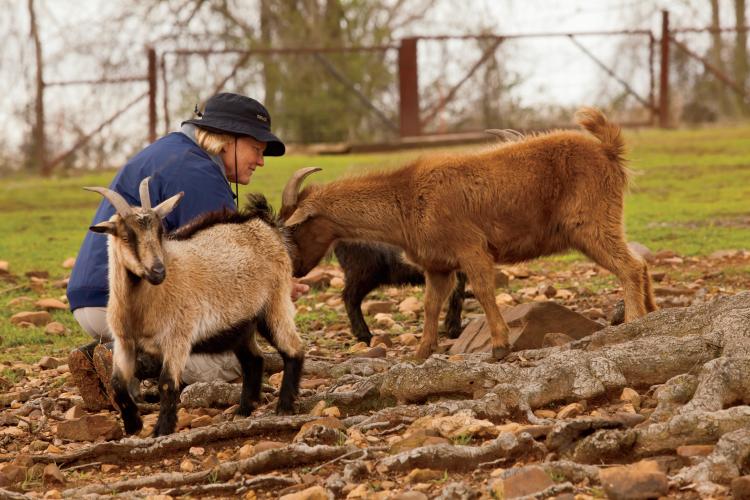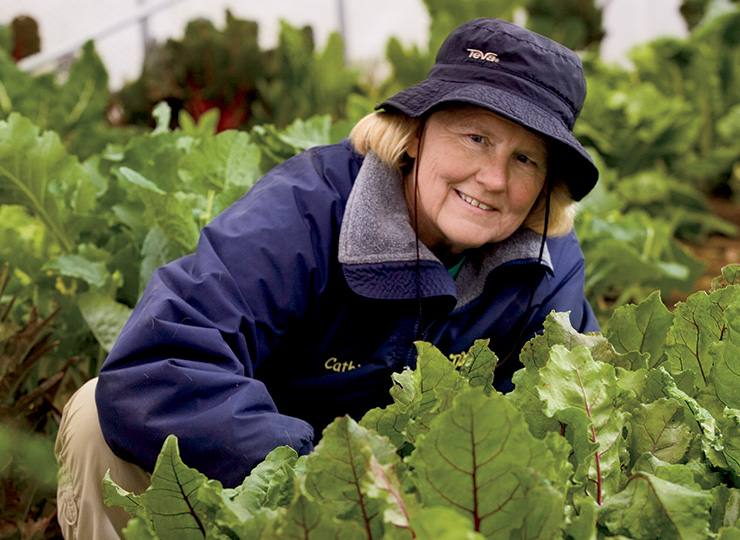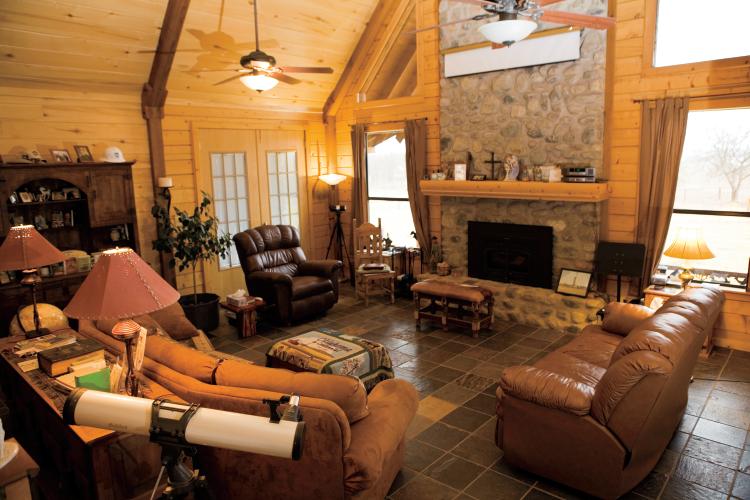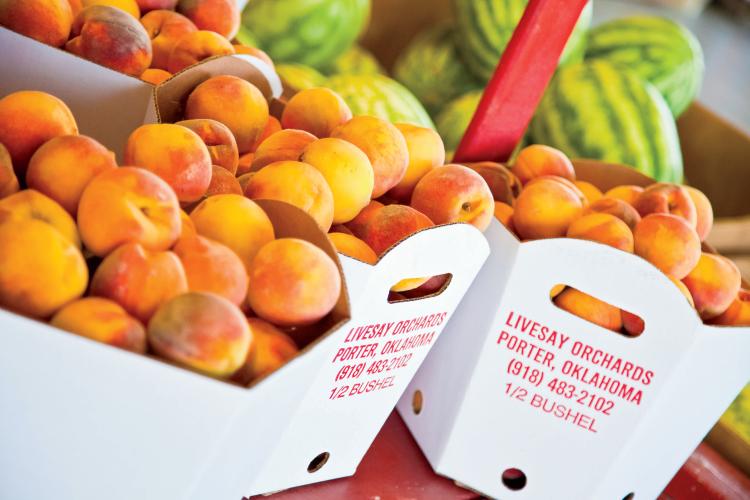Home > Oklahoma > Oklahoma Agritourism > Agritourism Destinations Use Fun to Connect Visitors with Agriculture
Agritourism Destinations Use Fun to Connect Visitors with Agriculture

The Agritourism program is aimed at introducing Oklahoma’s 3.8 million residents to agriculture as a premiere educational and entertainment destination.
Agritourism, a program within the Oklahoma Department of Agriculture, Food and Forestry, is introducing visitors to explorations in agriculture one click at a time, on a website (www.oklahomaagritourism.com) that offers a variety of adventures from farm to farm. The Agritourism program promotes more than 500 events and destinations – perfect for a weekend getaway or a weeklong vacation.
Agritourism has been defined as inviting the public onto a working farm or ranch to purchase products, learn, have fun or just relax. So grab your friends for a white-tailed deer hunt, bring the kids to pick strawberries, navigate a horse through a stream on a trail ride or find the perfect pumpkin.
“We have 12 different main categories – from country stays and guest ranches to u-pick and specialty crop farms where you can pick your own fresh berries or peaches,” says Jamie Cummings, Agritourism program administrator. “We even have a category called teachable moments that provides resources to teachers and educators to find destinations that offer a place for school kids to experience hands-on learning in many aspects of agriculture.”
In addition to Cummings, the Agritourism Program is led by two ODAFF coordinators. Lori Coats oversees the western region of the state, and Becca Lasich oversees the eastern region. Coats and Lasich travel their respective regions visiting venues, offering advice and discussing opportunities with potential vendors.
The team also partners with the Oklahoma Agritourism Association, a group of producers who share what they need to be successful and how ODAFF can help. The Agritourism Program assists agritourism businesses through consultation on new opportunities and promotion on the web, social media, the Agritourist newsletter and blog.
They offer “rolling tours” for producers, giving them a chance to visit other agribusiness ventures and learn from experts on subjects ranging from tax regulations to risk management and sharing new business opportunities.

Tools for encouraging agritourism visitors include a new website that will launch in summer 2013 with the ability to create custom itineraries – so if you’re traveling from Dallas, Texas, to Vinita, Okla., for example, you’ll be able to find every agritourism farm in between.
And they are adding more to the program every day. The program will soon launch a country wedding category, from full-service locations to those that offer a horse and carriage rental for the bride and groom.
“And we just got a grant to do a wine trail,” Cummings says. “We’re working with wineries throughout the state. We are so excited about the growing winery industry in the state and are looking for ways to share that with Oklahomans.”
Agritourism posts activities through social media, from different events such as a small town’s watermelon festival to when hunting season opens. You can find Oklahoma agritourism on Facebook, Twitter and a blog called The Vine.
“Mostly, we highlight whatever is in season,” she says. “In April, it’s farmers markets; in September, it is mazes and pumpkin patches.
As far as visitors go, many of those interested in agritourism are far removed from farm life.
“We get a lot of folks who have never been on a farm before,” she adds. “Those are the people we want to introduce to how much fun it can be. Agritourism is about getting back to your roots and making memories while enjoying the great outdoors.”

Red River Ranch Retreat
One agritourism destination providing that outdoor enjoyment is Red River Ranch Retreat in Sayre, Okla. Eleven years ago, Elizabeth and Ridge Lamar began living the dream to develop a Christian retreat in southwestern Oklahoma.
“We started with a cement stock tank and a mobile home,” says Elizabeth Lamar. “I had worked in missions, and my husband was a pastor. We wanted a place for people to come and relax.”
They built a four-bedroom log home for a bed-and-breakfast, a cabin with an adjoining suite, added a hiking cabin and turned the mobile home into a bunk room with a big porch.
There are horses for trail rides that navigate travelers through streams, along with fishing and hunting, paintball, a ropes course for team building and new this year – RV hookups.
“It’s beautiful country,” says Lamar, “and so peaceful. There are bluffs that you can ride up to and it looks like you’re on top of the mountain. On the very top is a tree – we call it our prayer tree. We stop and have prayer with the riders. People come year-round. It’s definitely prettiest when the wild flowers and trees are in bloom.”
And there will be more.
“We don’t feel like we’re finished,” she says. “At the moment, we’re building an activity center with a laundry, big kitchen and activity room.”

Livesay Orchards
If you’re looking for peaches in Oklahoma, the town of Porter comes to mind for locals. Located 40 minutes southeast of Tulsa, Porter is known as the peach capital of the state.
Livesay Orchards is the state’s largest peach orchard, offering peach everything – u-pick peaches from June through mid-August, peaches from the farm market through October, peach jam, peach butter, peach barbecue sauce and peach salsa. But it’s the orchard’s beautiful blooms that let neighbors know when spring arrives – and that peaches will come soon after.
Brothers Kent and Steve Livesay operate the orchard with help from their father, David. Their uncle, Austin Livesay, purchased the orchard in 1966 (with the first peach tree planted back in the 1920s) and has kept it a family operation. Currently, it has more than 140 acres of peach trees.
“Great Uncle Austin was a cotton farmer,” says Kent Livesay. “He first saw this property in the 1940s, but he wasn’t able to get it at that time. Twenty years later, he purchased it, and at the time, it had 55 acres of peaches and 45 acres of apples. He died, and my dad took it over. He’s retired now, and we’ve taken it over.”
The family doesn’t limit the farm to peaches, however. There are apple trees, soybeans, corn, tomatoes, sweet corn, milo, cattle, an open-air farm market, fruits and vegetables, a pumpkin playland and hay rides.
Wild Things Farm
At Wild Things Farm in Pocola, located on the eastern edge of Oklahoma, the annual season begins with strawberries and continues with blueberries and blackberries that you can pick yourself or simply buy from the stand. They also offer all kinds of fresh vegetables – asparagus, cucumbers, eggplant, gourds, herbs, lettuce, melons, okra, peppers, pumpkins, peas and more. There’s a place for birthday parties and a weeklong kids’ camp, school tours, hayrides and a corn maze.
“When we started, we planned to grow wildflowers,” says Cathie Green, who operates the farm with husband Jim and son Ryan. “But we found out it was too humid and not conducive to growing them, so we asked ourselves, what can we do to generate income? With no farming background, we bought 90 acres and started with the strawberries.”
The first year, they survived an ice storm that damaged the strawberry crowns, and like any good farmer, hoped for a better year the next year. Since then, they’ve never looked back. When a teacher asked if they grew pumpkins, they started planting.
The farm now runs a Community Supported Agriculture, or CSA, program, where they grow vegetables for people who buy shares to pick up weekly.
“It’s harder than I ever dreamed, but we enjoy every minute of it,” Green says.
During a cold snap this spring, the family was up for three straight nights protecting the strawberries from frost.
“We like having kids around – teaching them,” she says. “You ask a kid that hasn’t been here where strawberries come from, and he thinks it’s Walmart. We want them to know peanuts grow underground and what a cotton plant looks like.”
Green grew up in southern California, pursued a profession as a nurse practitioner and retired to run Wild Things Farm. “It’s a different kind of nurturing,” she says. They’re getting ready to start a hydroponics operation and hope to eventually add an orchard.
Green credits Cummings’ efforts with some of her farm’s success. “Oklahoma Agritourism has been a great program with its maps that show everyone,” she says. “They also develop the materials that we hand out and helped us get the Department of Transportation sign for the farm. Without them, I’m not sure we’d have it yet.”
She finished an Easter egg hunt in the spring and eagerly started strawberry season in late April, followed by a kids’ fishing tournament in May. A summer farm camp for kids is held in June, there’s garden production throughout the summer, pumpkins in the fall and then Christmas activities.
Brett Addison of Burneyville has added agritourism to his family’s cow-calf operation.
“We were living in Texas, working with my family, when the opportunity came to buy this property in Burneyville,” he says. “When we came here, the first thing we noticed was that the wildlife was unreal – especially the white-tailed deer. They were trophy quality.”
The couple decided to offer hunters a place to find their white-tailed deer, pigs, turkeys and ducks.
“We love doing this,” Addison says. “And it works well with the cattle operation. I can remember an older fellow saying to me that it amazed him how many people started doing something they didn’t love – and kept doing it all their life. I’m determined to do what I love. This isn’t what I went to college for – I have a degree in electrical engineering – but this is what I love.”
They started with a hunter’s cabin and put the word out. People began coming from all over. Addison leads the hunts while wife Lisa cooks and keeps the operation clean, and their son helps with guiding.
Once a year, they have a ladies-only hunt. Often, they have groups of men drive or fly in to hunt turkey, hogs or deer. When a group is successful, Addison works with a nearby processor to ship the game meat home and also has cold storage on the farm.
“It’s a family operation,” Addison says. “This is a great fit. We couldn’t do the deer without the cattle and vice versa.”



